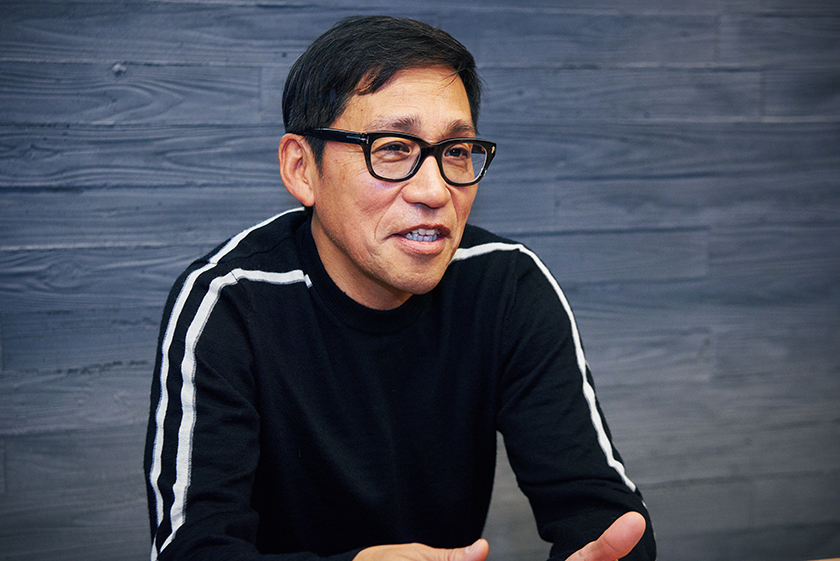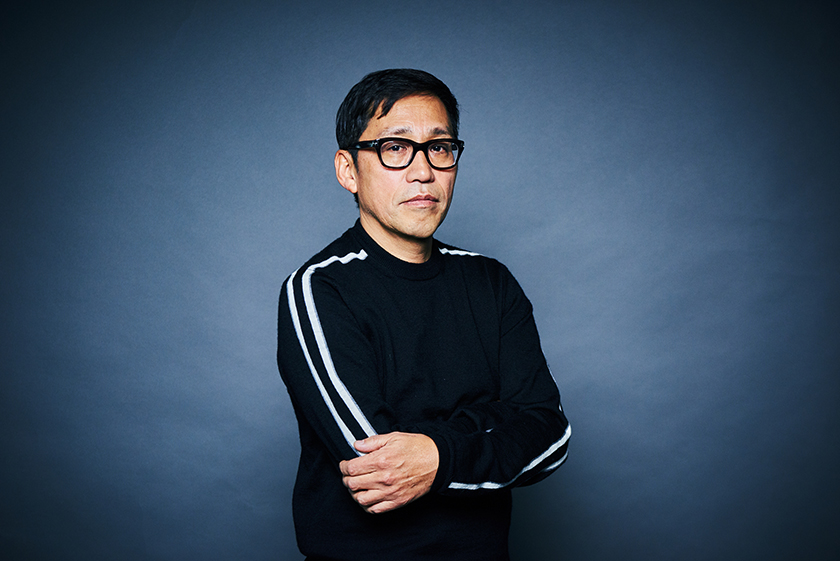The commercial series for Hazuki Lupe (a new line of powerful and durable eyeglasses), stars a luxurious cast reciting humorous lines in gorgeous settings and dynamic over the top cinematography for an indescribably satisfying mismatch of elements. It is hard for many to hide their astonishment when they find out who the creator is; none other than Masashi Muto, renown director responsible for numerous acclaimed music videos for top artists such as Namie Amuro and Ayumi Hamasaki. J-POP claimed the 90s, the internet stole the scene in the 00s, and now we live in a time where people literally carry movies in their pockets. Where does Masashi Muto stand in all of this? Well he doesn’t exactly stand. He has made leaps and bounds, soaring over the many new obstacles that the times throw at him—or any creator for that matter. We sat down with the man himself to shine some light on his encounter and career with film.

The “inevitable” crossover
from fashion to music

“I was first intrigued by fashion. It wasn’t music, not even film,” speaks Muto. “The fashion industry was in full bloom in the 80s, with companies like DC Brand. Each brand was making their own video and I was also involved in the production of those. The fashion shows always used the latest music for their visuals. I remember Techno and House were playing all over the place. The fashion industry is about half a year ahead of the rest of society in regards to new fads, so it was really stimulating to get to listen to new artists and music so much earlier than everyone else.”
Muto started his video production career by jumping into the fashion field that he loved so much, which put him in touch with the latest music and drastically changed his perception of things. This eventually led him to his reencounter with an old friend who shared Muto’s amazing “sense of smell” for new things.
“Back then, while I made fashion related videos, I also used to VJ at clubs like GOLD(located on 3-chome of Kaigan, Minato Ward) and Yellow(located on 1-chome of Nishiazabu, Minato Ward). This was around ’89, ’90. Everything was analog. I might have even been Japan’s first video jockey. Matsuura-san (current Avex Chairman) used to come to the events I organized and we got to know each other. That’s how I came to be involved in Avex. He asked me if I could introduce him to someone who could design the jacket for an artist at the time, so I hooked him up with a designer friend of mine. Avex used to run lots of late night commercials—which is now a famous story in the industry—and the commercial for the compilation CD they were putting out was the first job I worked on with them.”
“Their label still wasn’t that well known at the time and I suggested to Matsuura-san that it might be a good idea to put a so-called sound logo at the end of the commercials, so we did.”
His meeting with Matsuura was fate; it turned out to be what drew him to music videos. It was just around the time when Avex was planning to release one of their artist’s CDs.
“The first MV we made was EZ DO DANCE by TRF. MVs weren’t really a popular thing at the time so there was no real reference for making it. I had no choice but to use the knowhow I had from creating fashion adverts. I think I was the only one with the style of bringing fashion into music.”
Meeting Tetsuya Komuro
and creating an
unparalleled style.

One of the most pivotal moments in Muto’s career was his meeting with Tetsuya Komuro. He made the MVs for the top mid ‘90s artists that Komuro produced, such as Ryoko Shinohara, Arisa Mizuki, Namie Amuro, Globe and many others.
“Indeed, you could say that meeting Komuro-san was the turning point in my career,” says Muto. “Up until then I had only made videos for dance music artists like m.c.A-T or TRF. After meeting Komuro I naturally started doing pieces for singers like Tomomi Kahara or Hitomi. The experience helped hook me up with later Avex artists like Hitomi Yaida and bands like L’Arc-en-Ciel.”
Muto also reminisced about how exhausting it was working with Tetsuya Komuro, the most sought out producer of the time whose artists were selling millions after millions of albums and singles.
“There was one project we had for the group Globe and their new release of BRAND NEW globe 4 single where they wanted to put out four different singles at the same time. Komoro told me, “I want you to make four music videos in two days.’ I was like, ‘Hang on now, there’s no way that’s impossible,’ but he was stubborn and wouldn’t let me go home until I agreed, haha. In the end we were able to film the four videos in two days. We rented three rooms in studio, set everything up and just went to work for 48 hours without sleeping...”
Muto gained the firm trust of many artists and people throughout the industry and went on to film an immense amount of music videos. His works drew out the charm in those artists and their music yet they all boasted undeniable originality and something that no one had really seen before.
“As for daily inspiration, I got it more from foreign fashion magazines or art magazines instead of any video or film. Since I started out as a visual creator for the fashion world, I was more of the type to get ideas through still images. I never drew storyboards and usually just decided on the overall content and settings, and the rest I would get a feel of what to do at the shoot, talking to the actors and staff. That was my style. I thought that being able to adjust to whatever came up and being flexible even during the shoot was important for making something good. I don’t like deciding everything to a tee during the planning stage. I think the inspiration you get at the shoot is important.”
Beyond music videos and commercials, to the world of uncharted visuals

As a commercial director as well, one of Muto’s many pieces that has been gaining quite the attention recently is the Hazuki Lupe commercial. Muto filled us in as to exactly what separates this commercial so far apart from his past work.
“The Hazuki Lupe commercial was made pretty differently from your average commercial. It was a two-man collaboration between me and the client’s chairman (Hazuki Company Chairman Kenzo Matsumura) put together from scratch. The cast was pretty unique, but there were other parts that made it even more so. First of all, it was 60 minutes long. No one does that. Usually commercials are 15 to 30 seconds long. When you make one multiple times the length of the rest, you have a lot more freedom from time constraints. Another thing is we put the product’s name “hazuki lupe” in everyone’s lines. This allows the name to naturally slip into the viewer’s memory. It’s these flexible ideas that really made the creation process for this commercial original.”
One might think going from music videos to commercials would be a bit bland for the creator, but Muto spoke of how they both have their own charm.
“Music videos and commercials are completely different in how they are approached. But there is one thing about creative work, may it be MVs or commercials or, or anything really, and that’s, you have to have fun. The harder the actual process, the bigger the excitement and feeling of accomplishment when you’re done. That becomes your motivation. When the going gets tough, you get tougher. It feels that much more awesome the bigger the hurdle you have to get over. I think that has been the source of my drive and passion for making film.”
Nowadays many people enjoy videos on their smartphones and the soft world has caught up accordingly to accommodate the hard as many original programs are being streamed online. What does Muto have to say now that circumstances have completely changed for video media?
“Things like YouTube have been trending hard recently, but personally, I’d like to take a stab at something longer, like movies, instead,” says Muto. “There were a lot of movies in 2018, like Bohemian Rhapsody or One Cut of the Dead [Kamera wo Tomeruna] that must have been stimulating for their creators and have made me even more interested in film making. Of course, there are less and less people watching TV and there are a lot of young people who don’t any more, they watch videos on their phones, but that doesn’t mean I’m going to drop things at my age and dive into online video making. That’s not very realistic. I’m more interested in good ol’ cinema. Of course if something comes up I may just try my hand at TikTok, haha.”
In the entertainment world, where things that were “cool” yesterday can become “cheesy” in the blink of an eye, Muto continues to hold his position as a top creator. His sturdy gaze on what lies ahead of him and his unwavering passion for the creative process is what has kept his career going for decades and for someone with a record like his, he remains surprisingly flexible and youthful. When new technology syncs with creativity, who knows what videos will come next. Be sure to keep an eye on Muto.

Avex Entertainment Inc.
Planning & Development
Masashi Muto









